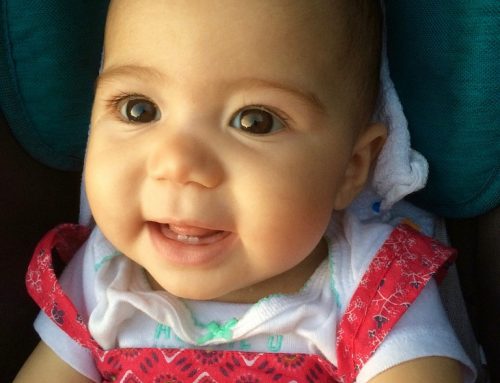As a new mother, my default setting was panic. My son would let out three sneezes in a row, and I would rush him to the doctor, cradling him in my arms – Bollywood style, while morbid music played out loud in my head. The wise, level-headed doctor would take one look at me through his experienced eyes, and laugh till his shoulders shook.
I had all the signs of ‘the first time, young mother’. I saw death traps everywhere. I was at constant war with germs. And I was always too worried to enjoy my lovely, bouncing baby.
I made so many emergency visits to my son’s doctor. Only to be told by the medical veteran, “Come, don’t come… your son will still heal on his own.”
His Yoda-like mannerisms aside, he taught me a valuable parenting lesson. He made me realise every childhood illness did not indicate something dire. Kids got sick and recovered quickly. Sometimes, if the symptoms were far more severe, proper medical attention was required. But more often than not, both my kids got over their colds and fevers quite quickly.
So to ease the minds of parents like me, we’ve created a collection of typical symptoms for common childhood illnesses. Find out what’s normal and what is not. And when to run to the doctor.
Checklist for common illnesses
#1 Nose and chest-related issues
It happens quite often. A toddler to walk into school and walk out with a cold. A common complaint amongst most parents is the infection that gets passed around from child to child. After all, a kid thinks nothing of wiping his nose onto the sleeve of his best friend. Viral germs are spread around on the playground, causing children to get colds quite often. Their still-developing immunity isn’t quite ready to fend off the germs. With every recovery, the body does get a bit stronger. As mentioned before, a succession of sneezes isn’t a cause for worry. Unless there are other signs or symptoms indicating something far more severe.
When it’s normal
Common symptoms:
- Sneezing
- Runny nose/Stuffy nose
- Breathing through the mouth
- Watery eyes (thick runny eye crusts on waking up)
Most likely to be:
One of the most common childhood viruses, the common cold. Colds can last one day or up to two weeks.
When you might get concerned
Additional symptoms:
- Mild to high fever up to 104 degrees Fahrenheit
- Body ache
- Heavy head or headaches
- Fatigue or lethargy
Mostly likely to be: Influenza, AKA the flu. The fever can last for 3 to 5 days, but the other symptoms might persist for longer.
Warm fluids, cold medicine and bed rest are some of the remedies to fight this childhood infection. If the symptoms go on for long, it could be dust allergies, which can be managed by limiting your child’s exposure to dust.
When to contact your doctor:
Worrying symptoms:
- Shivering
- Chills
- Vomiting
- Chest pain
- Sustained appetite loss
- Restlessness
- Unusual paleness
- Wheezing and consistent coughing
Most likely to be: Pneumonia or bronchitis. Pneumonia can last up to 2 weeks if it is a viral infection. If a bacterial infection causes the illness, it is treated with antibiotics and can end in a week.
#2 Skin-related issues
Rashes are quite common in children, although quite unpleasant. The sight of inflamed, angry red spots on your child’s otherwise perfect skin can be daunting to look at. If unaccompanied by other more serious symptoms, a rash isn’t a cause for worry as long as you keep your child comfortable.
When it’s normal
Common symptoms:
- Raised red bumps
- Itchy skin
- Flaky, dry skin
- Warm, sensitive skin
Most likely to be: prickly heat which is caused by overheated skin, especially in the summers. The rash can disappear in 2-3 days if your child’s skin is kept clean and dry. It could also be a case of cradle cap if the rash is mostly on the scalp. Or it could be baby acne if the rash is around the face. Check out our posts on both these issues to know more.
When to be concerned:
Additional symptoms:
- Isolated rash on parts of the body (like palms, feet or buttocks area).
- Fever
- Loss of appetite
- Irritability
Most likely: hand, foot, mouth disease if the rash is centred on the three mentioned body parts. Could also be diaper rash, if the red bumps are on the nappy-covered area.
When to contact your doctor:
Worrying symptoms:
- High fever
- Cold-like symptoms
- Red-brown rashes or blisters
- Fatigue
- Body ache
- Runny nose
Most likely to be: either measles or chickenpox, which are considered common diseases in children. Both illnesses don’t have medical treatment, but there are a few home remedies to help soothe your child’s discomfort.
#3 Stomach-related issues
“Ma! My tummy hurts!” is quite a common complaint among kids. While mothers frantically try to decode the source of the pain:
“Did you eat something bad?”
“Do you want to poop?”
“Did you finish your homework?”
Stomach pain can be challenging to figure out. In most cases, if the child only has pain in the abdominal area, and no other symptoms, he might recover quickly.
When it’s normal
Common symptoms:
- Complains of pain in the abdominal area
- Curling the body to ease discomfort
- Nausea
Most likely to be: gas or indigestion that is caused by swallowing gulps of air, probably when eating too quickly. The gas will pass out of the body naturally, and your child should feel relief within 24 hours.
When to be concerned
Additional symptoms:
- Vomiting
- Loose motions
- Fever
- Dehydration
Most likely: Diarrhoea or stomach flu. It’s best to let your child ride it out without medication to stop the vomiting or loose motions. Keep him hydrated and rested while in recovery.
When to contact your doctor
Worrying symptoms:
- High fever
- Chills
- Loose motions or constipation
- Pain is in the lower right side of the abdomen
- Pain keeps increasing rapidly
- Loss of appetite
Most likely: appendicitis if the pain is where the appendix is located. This is a serious case, and your child might need to go in for surgery as soon as possible. Another issue could be intussusception, where your child could be facing some problems in his intestines and requires medical attention. Check out our post on intussusception for more information.
#4 Fever-related issues
A child gets a fever, and it induces a full-blown panic attack in his parents. We’ve come to dread fevers. The minute the skin feels warm and sluggishness sets in, we’re at the doctors’ clambering for fever medication. But the truth is, fever isn’t such a bad thing. When your child has an internal infection, the body temperature rises in an attempt to eliminate the germs. It’s the body’s perfectly designed defence mechanism. Remember, fever is not an illness but an indicator of underlying infection.
When it’s normal
Common symptoms:
- Fever is less than 102 degrees Fahrenheit
- Your child is relatively active and happy (especially after the fever subsides with antipyretic medicines)
- Other bodily functions are normal
Most likely to be: mild bacterial or viral infection that isn’t serious or harmful in the long run. The fever will break in a day or two on its own. Vaccination shots can also cause short term fever in children, as your doctor will tell you. However, if your child is three months or younger and contracts a fever over 100 degrees Fahrenheit, it’s best to call your doctor.
When to be concerned:
Additional symptoms:
- High fever over 103 degrees Fahrenheit
- Runny nose
- Cough
- Body ache
- Lethargy and fatigue
Most likely to be: A viral or bacterial infection that could subside in a couple of days. If your child is uncomfortable or unable to sleep, your doctor could prescribe fever-breaking medication.
When to contact your doctor
Worrying symptoms:
- High fever over 104 degrees Fahrenheit
- Fever doesn’t ‘break’ with medicine
- Doesn’t subside after 3-5 days
- A child is unable to move around much
Most likely to be: to be a serious health problem. Get your child checked for a variety of diseases, depending on the symptoms. Consult your doctor about the maximum fever threshold following which your child will need medical intervention. Depending on your baby’s age and other parameters, a ‘wait-and-watch’ threshold can be 101-104 Fahrenheit. It is always good to discuss this threshold with your paediatrician. Read our post on fever management to know more.
Conclusion
Your first priority is your child’s health. And anytime the levels dip below normal, it can be quite agonising to deal with. However, your child is still developing his immunity and is far more susceptible to fall ill. Every time your child gets sick, it triggers his body into fighting the ailment, thus generating the antibodies which are making him stronger in the process. So keep a watchful eye on each symptom, watch the duration of the illness and only panic when it’s absolutely necessary.






Leave A Comment